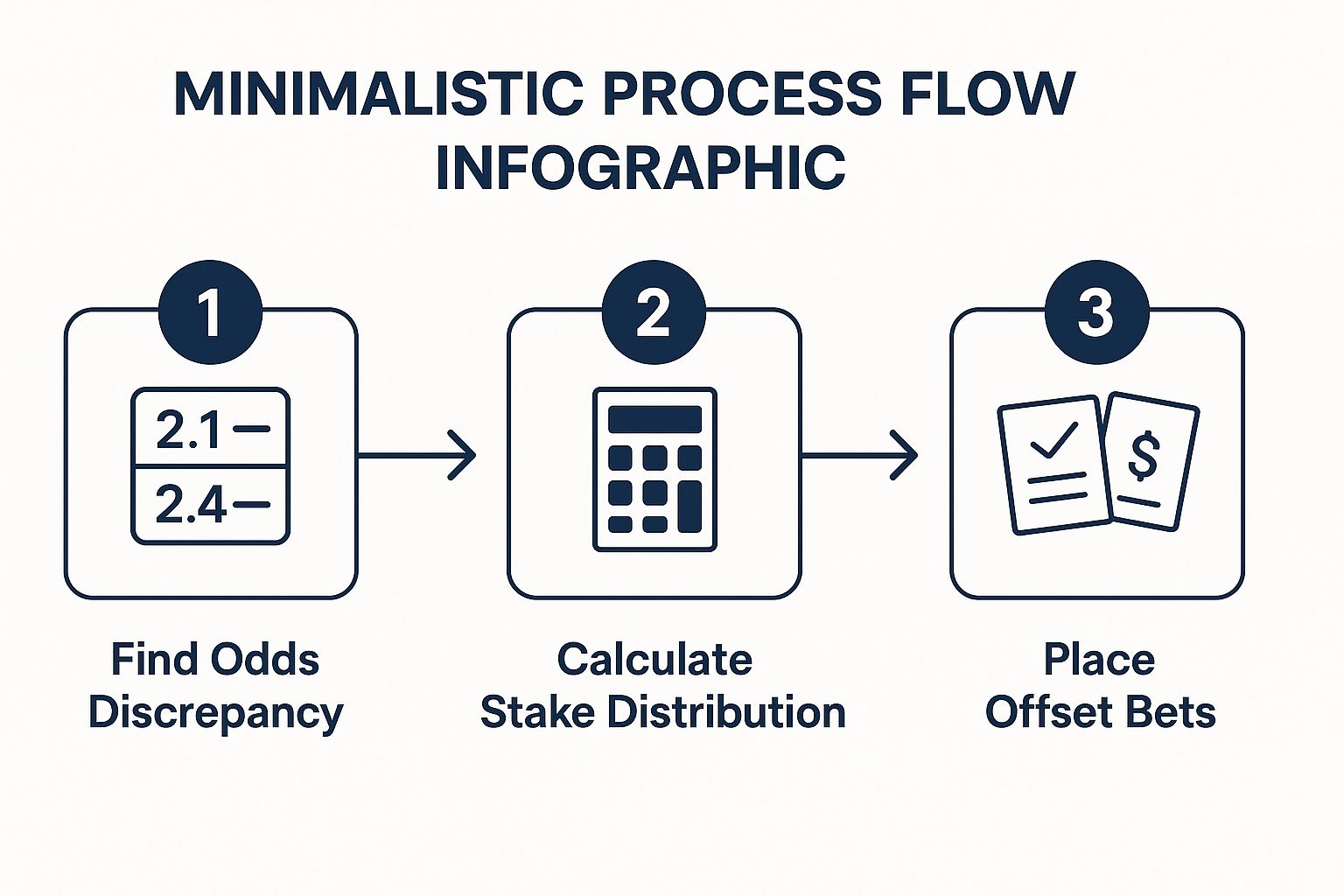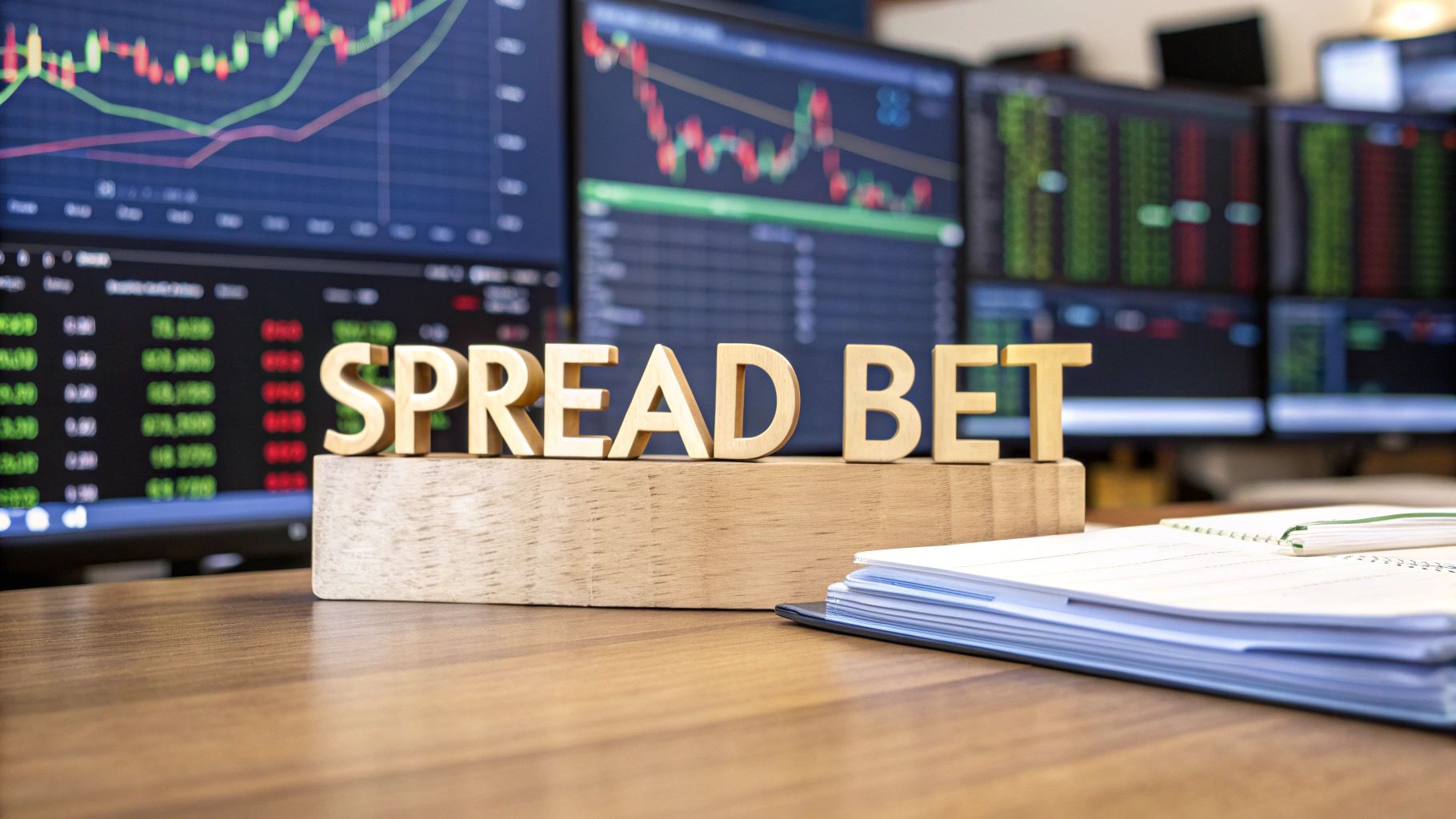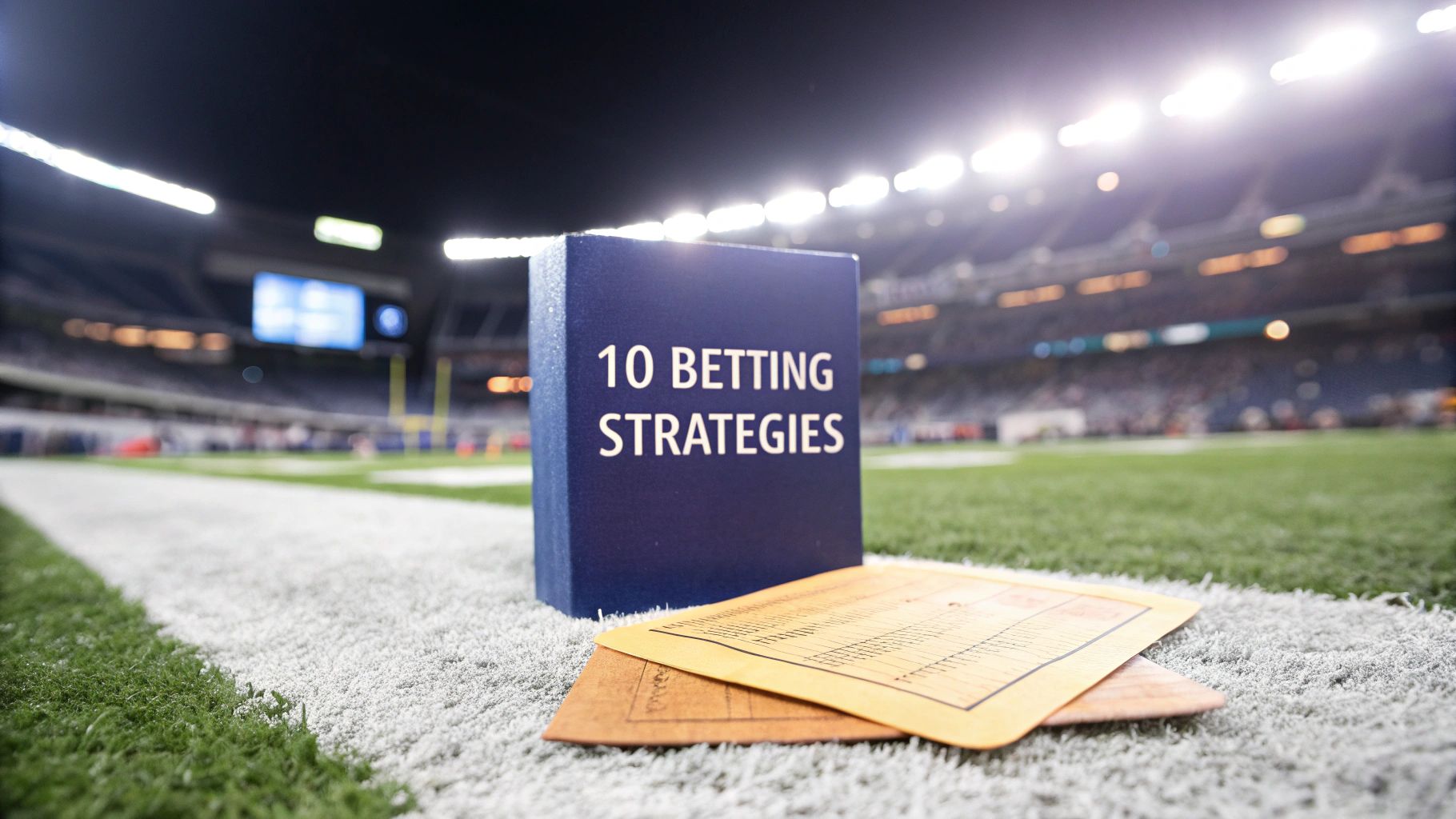
10 Proven Sports Betting Strategies to Use in 2025
Discover 10 powerful sports betting strategies, from value betting to statistical modeling. Unlock data-driven insights to make more informed wagers today.
Are you ready to elevate your game from casual punts to calculated plays? The world of sports betting has evolved, and relying on gut instinct alone is no longer enough to secure consistent returns. The key to long-term success lies in disciplined, data-driven approaches that give you a demonstrable edge. This guide is your blueprint, designed to move you beyond simple predictions and into the realm of strategic investment.
We will explore ten proven sports betting strategies used by professionals to methodically gain an advantage over the bookmakers. You won't find generic advice here; instead, we will break down the mathematics, psychology, and practical steps behind each powerful method. We'll cover everything from identifying undervalued odds with Value Betting to guaranteeing profits through Arbitrage Betting and optimising your stakes with the Kelly Criterion.
Whether you're a seasoned bettor looking to refine your process or a newcomer determined to start on the right foot, this comprehensive list provides the structured framework you need. By mastering these concepts, you'll learn how to analyse markets, manage your bankroll effectively, and ultimately bet smarter, not harder. Let's begin building your winning approach.
1. Value Betting Strategy
The most successful sports betting strategies focus on long-term profitability, not just single wins, and at the core of this philosophy is value betting. This isn't about picking winners; it's about finding odds that misrepresent an outcome's true probability. In essence, you are buying a bet at a price you have calculated to be a bargain, giving you a mathematical edge over the bookmaker over time.

Imagine you analyse a Premier League match and determine a team has a 50% chance to win, which translates to true odds of 2.00. If a bookmaker offers odds of 2.20, that represents a "value bet". By consistently placing wagers where the offered odds are higher than your assessed probability, you are setting yourself up for profit over hundreds or thousands of bets, regardless of individual outcomes. This is the exact approach used by professional syndicates and legendary bettors like Tony Bloom.
How to Implement Value Betting
- Develop a Model: Create a systematic way to calculate true probabilities. This can range from a sophisticated statistical model to a simpler system based on key performance indicators like expected goals (xG) in football or player form in tennis.
- Compare Odds: Use an odds comparison tool to shop for the best price across multiple bookmakers. Even a small difference in odds can significantly impact your long-term returns.
- Set a Threshold: Only place bets when you identify a significant value edge. Many professionals won't bet unless their calculated edge is at least 4-5% to account for potential errors in their model.
- Record Everything: Keep meticulous records of your bets, the odds you took, your calculated true odds, and the outcome. This data is crucial for refining your model and verifying that you genuinely have an edge.
This strategy requires discipline and analytical rigour, but it is the most reliable path to sustained success. By shifting your focus from simply predicting winners to identifying pricing errors, you transform gambling into a form of educated investment. For a deeper understanding of how to find these opportunities, you can learn more about how to find value bets by tracking odds movement.
2. Arbitrage Betting (Sure Betting)
While most sports betting strategies involve accepting risk for potential reward, arbitrage betting offers a mathematical certainty of profit. Known as 'arbing' or 'sure betting,' this method involves exploiting price discrepancies across different bookmakers. By placing precisely calculated wagers on every possible outcome of an event, you lock in a small but guaranteed return, regardless of which team or player wins. It is a game of speed and precision, turning bookmaker competition into your personal advantage.
This infographic illustrates the core, three-step workflow for executing a successful arbitrage bet.

The process relies on identifying the opportunity, calculating the correct stakes, and placing the wagers before the odds are corrected. Imagine a tennis match where Bookmaker A offers odds of 2.10 on Player 1, and Bookmaker B offers 2.10 on Player 2. Betting on both creates a guaranteed profit because the implied probabilities add up to less than 100%. While the margins are slim, typically 1-5%, its risk-free nature makes it one of the most powerful sports betting strategies available.
How to Implement Arbitrage Betting
- Use Arbing Software: Arbitrage opportunities are fleeting, often lasting only minutes. Subscribing to an arbitrage alert service like RebelBetting is almost essential to find and act on these discrepancies in real-time.
- Maintain Multiple Accounts: To capitalise on price differences, you need active and funded accounts across at least 10-15 different bookmakers. This allows you to place the required bets instantly.
- Avoid Round Stakes: Wagering unusual amounts like £48.72 instead of a round £50 helps you avoid being quickly flagged and limited by bookmakers as an arbitrage bettor.
- Act Immediately: Speed is paramount. Once an opportunity is identified by your software, you must calculate your stakes using an arbitrage calculator and place all bets before the bookmakers synchronise their odds.
This strategy requires significant organisation and quick execution but removes the element of chance entirely. It’s a systematic approach to generating profit by leveraging inefficiencies in the betting market itself.
3. Kelly Criterion Staking
While value betting tells you what to bet on, the Kelly Criterion tells you how much to bet. This mathematical formula, developed by Bell Labs researcher John Kelly Jr., is one of the most powerful sports betting strategies for bankroll management. It calculates the optimal percentage of your funds to wager on a value bet to maximise long-term growth and minimise the risk of going broke.

The formula, (bp - q) / b, essentially weighs the probability of winning against the potential payout. For example, if you find a bet at odds of 2.00 (where b=1) and believe the true win probability is 55% (p=0.55), Kelly suggests staking 10% of your bankroll. This dynamic approach, famously applied by investor Warren Buffett and gambler Edward O. Thorp, ensures your stake size is always proportional to both your confidence and your available capital, preventing catastrophic losses from a single bad beat.
How to Implement Kelly Criterion Staking
- Be Conservative: The biggest risk is overestimating your edge. Always be conservative with your probability assessments to avoid overbetting and exposing your bankroll to unnecessary risk.
- Use Fractional Kelly: Full Kelly can be highly volatile. Most professionals use a "fractional Kelly" approach, betting only a portion (e.g., 25% or 50%) of the recommended stake to smooth out variance.
- Recalculate Constantly: Your stake should be a percentage of your current bankroll. You must recalculate your bet size before every wager to ensure it adjusts as your bankroll grows or shrinks.
- Verify Your Edge: This strategy is only effective if you have a genuine, demonstrable edge over the bookmaker. Meticulously track your results to confirm your probability models are accurate over the long term.
4. Matched Betting
While most sports betting strategies involve calculated risk, matched betting is a technique designed to eliminate it entirely. It's a mathematically proven method to profit from the free bets and promotions offered by bookmakers. The strategy works by covering all possible outcomes of an event, using the bookmaker's free bet on one outcome and placing an opposing "lay" bet on a betting exchange. This guarantees a profit, regardless of which team wins or loses.
For example, a bookmaker offers a "Bet £10, Get £30 in Free Bets" welcome bonus. You place a £10 qualifying bet and simultaneously lay the same outcome on an exchange, ensuring a minimal loss (perhaps a few pence). Once the free bet is credited, you repeat the process, using the £30 free bet to back an outcome and laying it on the exchange. This time, you will lock in a guaranteed profit of around 80% of the free bet value, so typically £24-£25, with zero risk. This approach was famously popularised in the UK by consumer finance expert Martin Lewis.
How to Implement Matched Betting
- Use a Service: Start with a matched betting service like OddsMonkey or Profit Accumulator. Their software finds the best offers and provides calculators that tell you exactly how much to bet and lay.
- Track Everything: Maintain a detailed spreadsheet to track your bets, profits, and account balances across multiple bookmaker sites. Organisation is fundamental to success.
- Find Close Odds: To minimise qualifying losses, look for events where the back odds at the bookmaker and the lay odds at the exchange are as close as possible.
- Stay Under the Radar: Vary your betting patterns and stakes to avoid being "gubbed" (restricted from promotions) by bookmakers. Don't exclusively bet on obscure markets with promotional funds.
Matched betting is not technically gambling but rather a systematic process. It’s the perfect, low-risk strategy for building an initial betting bankroll from the ground up, turning bookmaker marketing spend directly into your profit.
5. Betting Exchange Trading
Shifting from traditional bookmakers to betting exchanges unlocks one of the most dynamic sports betting strategies available: trading. This approach mirrors financial trading, where the goal is to profit from market fluctuations rather than the outcome of the event itself. By using an exchange like Betfair, you can both back an outcome (bet on it to happen) and lay it (bet on it not to happen), securing a profit by exploiting changes in odds before or during a match.
This strategy allows you to lock in a guaranteed return regardless of the final result. For example, a trader might back a horse at odds of 5.0 before a race. If significant money comes in for that horse and its odds shorten to 3.5, the trader can then lay the same horse. This creates a risk-free position, often called a "green book," where they will profit no matter which horse wins the race. It’s a sophisticated method that turns odds movement into a direct opportunity.
How to Implement Betting Exchange Trading
- Focus on Liquid Markets: Start with popular events like major football leagues or high-profile horse races. High liquidity ensures your back and lay bets are matched quickly at stable prices.
- Utilise Trading Software: Tools like Bet Angel or The Geeks Toy are essential. They provide one-click betting, real-time odds ladders, and market charts that are impossible to trade without.
- Learn Key Strategies: Begin by understanding foundational techniques. Scalping involves taking small, frequent profits from minor odds movements, while swing trading aims to capture larger price shifts over a longer period.
- Manage Your Risk: Implement strict risk management rules from day one. Define your entry and exit points before placing a trade and set a stop-loss to protect your capital if the market moves against you. Always factor the exchange’s commission into your profit calculations.
Exchange trading requires discipline and a deep understanding of market dynamics, but it offers a unique way to profit from sports without needing to predict the winner. By becoming a market participant rather than just a punter, you open up an entirely new dimension of strategic betting.
6. Handicapping and Statistical Modeling
For those who view sports betting as a data science challenge, handicapping and statistical modelling represent the ultimate strategy. This approach moves beyond simple form analysis to create proprietary systems that predict outcomes more accurately than the market. By leveraging historical data, advanced statistics, and situational factors, you build a model that assigns your own probabilities to events, allowing you to spot inefficiencies in the bookmakers' odds.
This is the domain of professional bettors and analytical minds like Haralabos Voulgaris, who famously built a fortune modelling the NBA. It involves treating sports as a complex system and finding a quantifiable edge. A successful model might predict an NFL point spread by factoring in weather, travel distance, and divisional rivalries, or a football match outcome using expected goals (xG) and shot quality data. The goal is to create a more precise forecast than the odds imply, making it one of the most powerful sports betting strategies available.
How to Implement Handicapping and Statistical Modeling
- Specialise in a Niche: Start with one sport or even a single league. Mastery requires deep, specific knowledge, so focus your data collection and analysis efforts where you can gain a genuine informational advantage.
- Learn the Tools: Gain proficiency in a programming language like Python or R. These are essential for handling large datasets, performing statistical analysis, and building predictive models.
- Backtest Rigorously: Before risking any real money, test your model against historical data. This process, known as backtesting, helps you verify its predictive power and refine its parameters.
- Start Simple, Evolve Gradually: Begin with a basic model incorporating a few key variables. As you gain confidence and understanding, you can gradually introduce more complexity and situational factors.
- Track Closing Line Value (CLV): Consistently beating the closing line is a strong indicator that your model is accurate. Track this metric to validate that you are identifying value effectively.
This strategy requires a significant investment in time and learning, but it offers the highest potential for a sustainable, long-term edge over the bookmakers. To get started with the foundational elements of this approach, you can explore the principles of tactical matchup analysis.
7. Betting Against the Public (Contrarian Betting)
Contrarian betting, often called "fading the public," is one of the more psychologically fascinating sports betting strategies. It operates on the simple but powerful premise that the general betting public is often driven by emotion and media narratives rather than objective analysis. Bookmakers understand this and frequently shade their lines to protect themselves against heavy, one-sided action from casual bettors, creating value on the less popular side.
This strategy isn't about blindly betting against favourites; it's about identifying situations where public bias has artificially inflated the price on the other side. For example, if 80% of the public bets on a popular NFL team to cover the spread, but the line moves in the opposite direction (e.g., from -7 to -6.5), this is a classic contrarian signal. This "reverse line movement" suggests that large, respected wagers from professional "sharp" bettors are backing the underdog, creating a value opportunity for those willing to go against the grain.
How to Implement Contrarian Betting
- Monitor Betting Percentages: Use reputable sources like Sports Insights or Action Network to track the percentage of bets and the percentage of money placed on each side of a game. A significant discrepancy often reveals the sharp versus public divide.
- Look for Lopsided Action: Target games where 70% or more of the bets are on one side. This is most common in high-profile events like primetime NFL games or major college football matchups where public interest is at its peak.
- Identify Reverse Line Movement: Pay close attention when the betting line moves in the opposite direction of the public betting percentages. This is the strongest indicator that sharp money is on the contrarian side.
- Don't Bet Blindly: Use this strategy as a tool, not a standalone system. Combine contrarian signals with your own handicapping to confirm that the unpopular side has a legitimate chance to cover the spread.
8. Middle and Scalping Strategy
One of the more advanced sports betting strategies, middling involves placing bets on both sides of a game at different lines to create a profitable "middle". This opportunity arises when a point spread or total moves after your initial wager. While the primary goal is often to create a situation where you can’t lose, hitting the middle results in winning both of your bets for a significant payout.
Imagine you bet on an NFL favourite at -3. The line then moves to -6.5 due to market activity. You could then bet on the underdog at +6.5. If the favourite wins by 4, 5, or 6 points, both of your bets cash. Scalping is a related concept, focused on locking in smaller, guaranteed profits by exploiting odds discrepancies or promotions across different bookmakers, effectively removing risk entirely.
How to Implement Middle and Scalping Strategies
- Target Volatile Markets: Focus on sports where lines move significantly, such as NFL, college football, and NBA. Key numbers in football (3, 7, 10) are prime targets as movement around them creates high-probability middle opportunities.
- Use Line Shopping and Alerts: Actively use odds comparison tools to find the best numbers for both sides of your middle. Set up alerts for specific games to be notified instantly when a line moves by a certain number of points.
- Calculate Your Risk: Before placing the second bet, calculate the potential outcomes. Understand the small loss you'll incur if the middle doesn't hit (the "vig") and weigh it against the probability and payout of hitting the middle.
- Leverage Promotions: Scalping is often easiest when using promotions like free bets or odds boosts. By placing a free bet on one outcome and a cash bet on the opposing outcome at another bookmaker, you can guarantee a profit regardless of who wins.
This strategy requires sharp timing and access to multiple bookmaker accounts. It shifts the focus from predicting a winner to exploiting market movements, turning betting into a calculated arbitrage-like activity.
9. Live Betting (In-Play Strategy)
Live betting, or in-play betting, is one of the most dynamic sports betting strategies available, involving placing wagers after an event has already started. Instead of pre-match analysis alone, this strategy capitalises on your ability to read the game as it unfolds, identifying moments when real-time odds don't accurately reflect the current situation. It's a game of speed, observation, and reacting to momentum shifts faster and more accurately than the market.

For instance, a statistically superior NFL team might go down 14-0 in the first quarter, causing their live odds to lengthen significantly. A sharp bettor recognises this as a likely overreaction and finds value in backing the favourite at a much better price than was available before kick-off. Similarly, if a top tennis player is broken early in the first set, their odds will drift, creating a prime opportunity to bet on them if you believe they will recover and demonstrate their true quality.
How to Implement Live Betting
- Prepare Beforehand: Don't just jump into a random game. Identify potential matches where you anticipate volatility or specific game scripts, and know what you are looking for before the event starts.
- Watch the Game: Relying solely on a stat feed is a disadvantage. Watching the live action gives you context that statistics can't, such as player body language, tactical adjustments, or momentum.
- Act Quickly with Multiple Bookmakers: Live odds change in seconds. Having accounts funded at several bookmakers allows you to quickly compare and grab the best available price before it disappears.
- Avoid Emotional Chasing: The fast-paced nature of in-play betting can lead to impulsive decisions. Set clear limits and stick to your pre-game plan, avoiding the temptation to chase losses with undisciplined wagers.
This strategy rewards those who can combine deep sports knowledge with quick analytical thinking. Mastering it requires understanding how to process information in real-time, a skill you can refine with tools that specialise in real-time odds tracking.
10. Dutching and Hedging Strategy
While many sports betting strategies focus on picking a single winning outcome, dutching and hedging are advanced tactics centred on risk management and guaranteeing profit. Dutching involves splitting your stake across multiple selections in an event, ensuring the same return regardless of which one wins. Hedging, conversely, involves betting against your original position to lock in profit or minimise potential losses, often used on futures or accumulator bets.
These techniques shift the focus from maximising a single win to securing a positive outcome. For instance, you might place a pre-season bet on a team to win a championship at high odds. If they reach the final, you can hedge by betting on their opponent, guaranteeing you profit no matter who lifts the trophy. Similarly, if the first four legs of a five-team accumulator have won, hedging the final game is a common strategy to ensure a payout.
How to Implement Dutching and Hedging
- Use a Dutching Calculator: Manually calculating the precise stakes needed to ensure equal profit across different odds is complex. Use one of the many free online dutching calculators to do the heavy lifting for you.
- Identify Hedging Opportunities: The best times to hedge are on long-shot futures bets that are close to winning or on the final leg of a high-value accumulator. The goal is to protect a potentially large payout.
- Calculate Hedge Value: Before placing a hedge bet, calculate if it offers genuine value. Sometimes, letting the original bet ride is the more profitable long-term play, even with the added risk. Don't hedge out of fear.
- Define Rules in Advance: To avoid emotional decisions, set your criteria for when you will hedge before placing the original bet. For example, you might decide to always hedge the final leg of any accumulator with a potential return over £1,000.
By mastering dutching and hedging, you add powerful risk-management tools to your betting arsenal. These strategies provide a safety net, allowing you to turn precarious positions into guaranteed wins and demonstrate a disciplined, professional approach to betting.
Top 10 Sports Betting Strategies Comparison
| Strategy | Implementation Complexity 🔄 | Resource Requirements ⚡ | Expected Outcomes 📊 | Ideal Use Cases 💡 | Key Advantages ⭐ |
|---|---|---|---|---|---|
| Value Betting Strategy | High – requires statistical analysis and probability calculation | High – extensive research, data, and knowledge needed | Long-term consistent profits with variance | All sports & markets where pricing errors exist | Mathematically sound, removes emotions, scalable |
| Arbitrage Betting (Sure Betting) | Medium – needs quick action, multi-account management | High – many bookmaker accounts, capital needed | Low returns per bet but risk-free profit | Any sport with bookmaker odds discrepancies | Guaranteed profit if executed correctly |
| Kelly Criterion Staking | Medium – uses mathematical formula, requires accurate probabilities | Medium – need for probability estimation & record-keeping | Maximizes bankroll growth over time | Optimal bet sizing where edge and bankroll known | Prevents overbetting, mathematically optimal |
| Matched Betting | Low – systematic process exploiting promotions | Medium – requires multiple accounts & capital | Risk-free profit, mainly from bonuses | New bettor promotions and reload offers | Risk-free, no sports knowledge needed |
| Betting Exchange Trading | High – needs market reading, quick decisions, software use | High – time-consuming, fast execution, software | Potential to profit regardless of event result | Liquid betting exchange markets, in-play events | Control bets, exit early, minimize losses |
| Handicapping & Statistical Modeling | Very High – programming, data collection, and advanced stats needed | Very High – data subscriptions, programming skills | Significant long-term edge if model accurate | Sports/leagues with rich historical data | Scalable, data-driven edge, removes bias |
| Betting Against the Public (Contrarian Betting) | Low-Medium – understanding line movement & public data | Low – access to betting percentage data | Exploits public biases, potential value bets | Major sports with heavy public betting | Simple concept, supported by academic research |
| Middle and Scalping Strategy | Medium – requires line monitoring, multi-account use | Medium – capital tied in multiple bets | Small profits or break-even, occasional double wins | Sports with volatile line movement (NFL, NBA totals) | Limited downside, potential for double wins |
| Live Betting (In-Play Strategy) | High – fast decisions, event watching, quick analysis | High – time-intensive, requires live data and multiple accounts | Multiple opportunities, hedging potential | Sports with momentum changes (tennis, soccer, basketball) | Exploits live odds inefficiencies |
| Dutching and Hedging Strategy | Medium – requires stake calculation, emotional discipline | Medium – capital spread across multiple bets | Reduced variance, guaranteed profit in some cases | Horse racing, futures, parlays, accumulators | Risk management, profit locking, downside protection |
Choosing Your Edge: Which Strategy is Right for You?
We've journeyed through a comprehensive arsenal of sports betting strategies, from the mathematical precision of Arbitrage and the Kelly Criterion to the dynamic, real-time tactics of Live Betting and Exchange Trading. You've seen how to identify genuine value, how to build sophisticated statistical models, and how to profit by going against public sentiment. Each of these ten methods offers a unique pathway to moving beyond simple luck and towards a more calculated, professional approach to wagering.
The most critical takeaway is that there is no universal "best" strategy. The ideal approach is deeply personal, aligning with your individual goals, risk tolerance, available capital, and the time you can dedicate to analysis.
Finding Your Fit: A Quick Recap
To help you decide on your next steps, consider which of these profiles best describes you:
- The Analyst: If you enjoy deep statistical dives and finding long-term, verifiable edges, then Value Betting and Handicapping/Statistical Modelling are your natural starting points. Your success will be built on patient research and disciplined execution.
- The System Builder: For those who prefer systematic, lower-risk approaches that guarantee profit when executed correctly, Arbitrage Betting and Matched Betting offer a structured way to build your bankroll. These methods are less about predicting outcomes and more about exploiting market inefficiencies.
- The Live-Action Trader: If you thrive on adrenaline and making quick, informed decisions based on the flow of a match, then Live Betting, Betting Exchange Trading, and Middling/Scalping will suit your style. These strategies demand focus and the ability to act decisively.
The Unifying Principle: Discipline and Specialisation
Regardless of the path you choose, success is impossible without unwavering discipline. Every professional bettor understands that managing your bankroll, sticking to your chosen system, and removing emotion from your decisions are non-negotiable fundamentals. Trying to implement all ten of these sports betting strategies at once is a recipe for disaster. Instead, select one or two that resonate with you, dedicate yourself to mastering their nuances, and apply them with relentless consistency.
This is where the real edge is found: not in a secret formula, but in the focused application of a proven method over time. By specialising, you transform general knowledge into a powerful, profitable skill set.
Ready to implement these strategies without spending countless hours on manual research? OddsHaven uses advanced AI to automate the heavy lifting of handicapping, analysing everything from xG and tactical matchups to live data, delivering high-confidence, value-oriented picks directly to you. Start making more informed, data-driven bets with OddsHaven today.
Ready to Start Winning?
Join OddsHaven and get instant access to AI-powered predictions with an 87% win rate on high-confidence picks
Try OddsHaven Free for 5 Days

